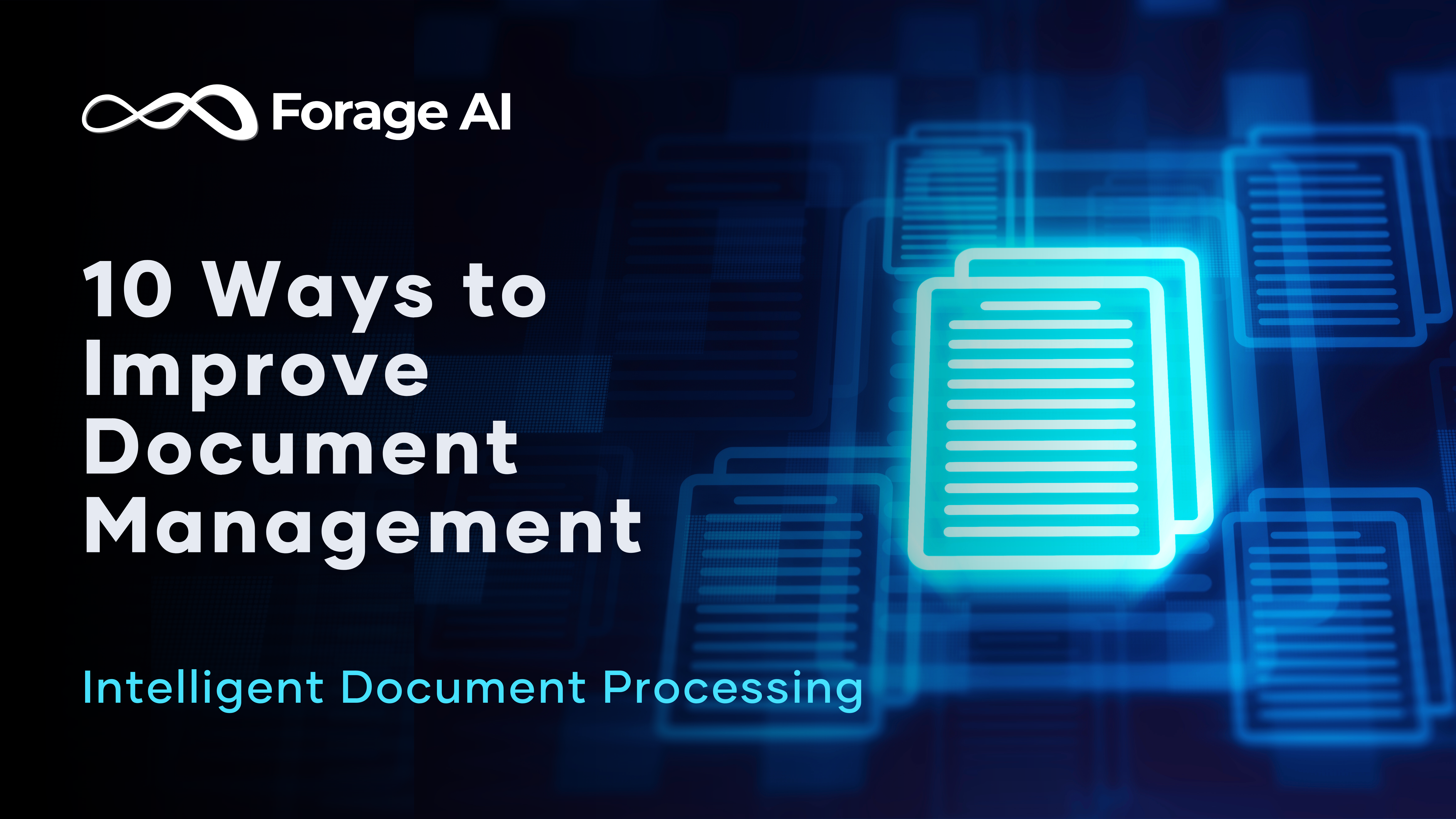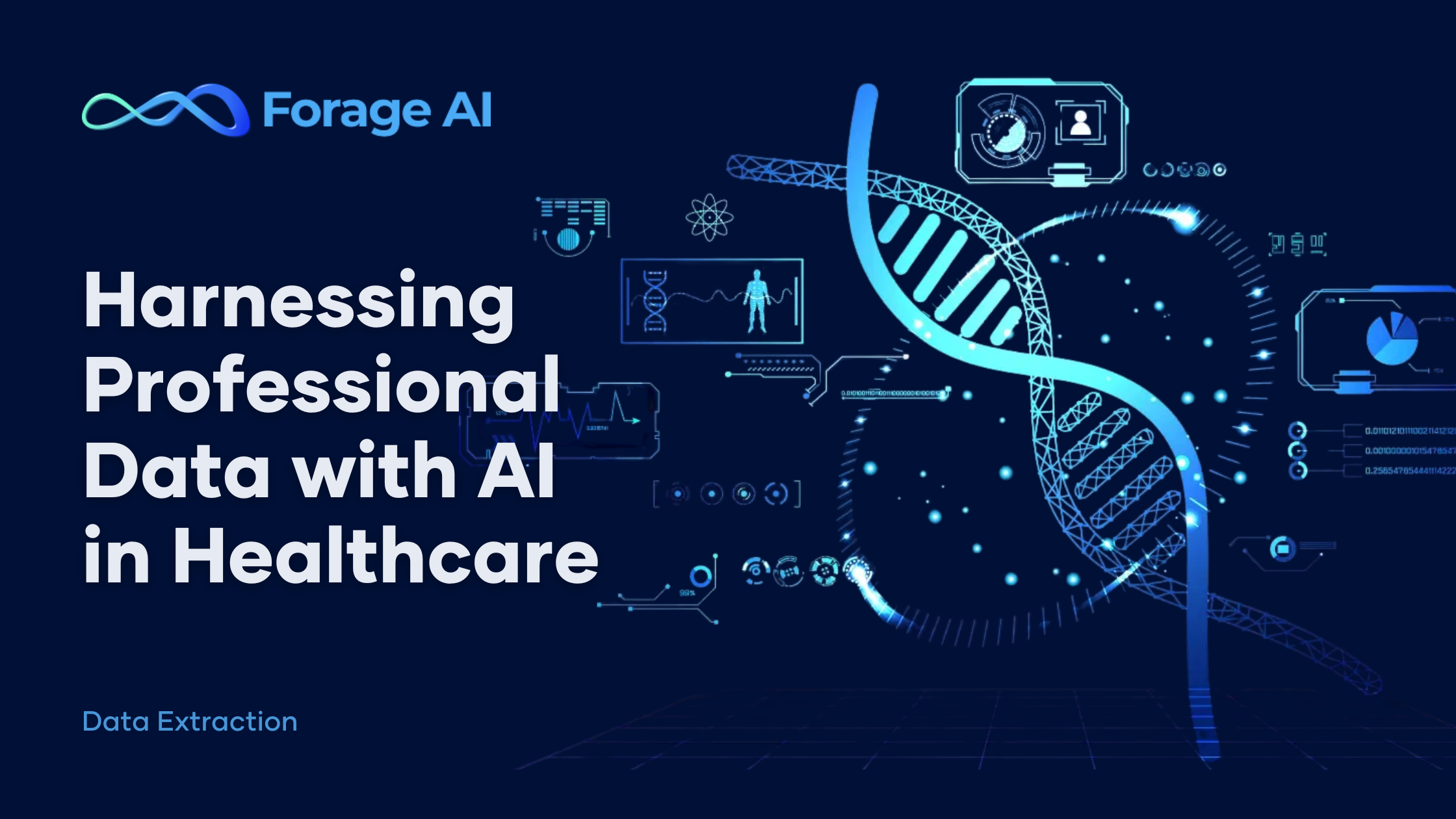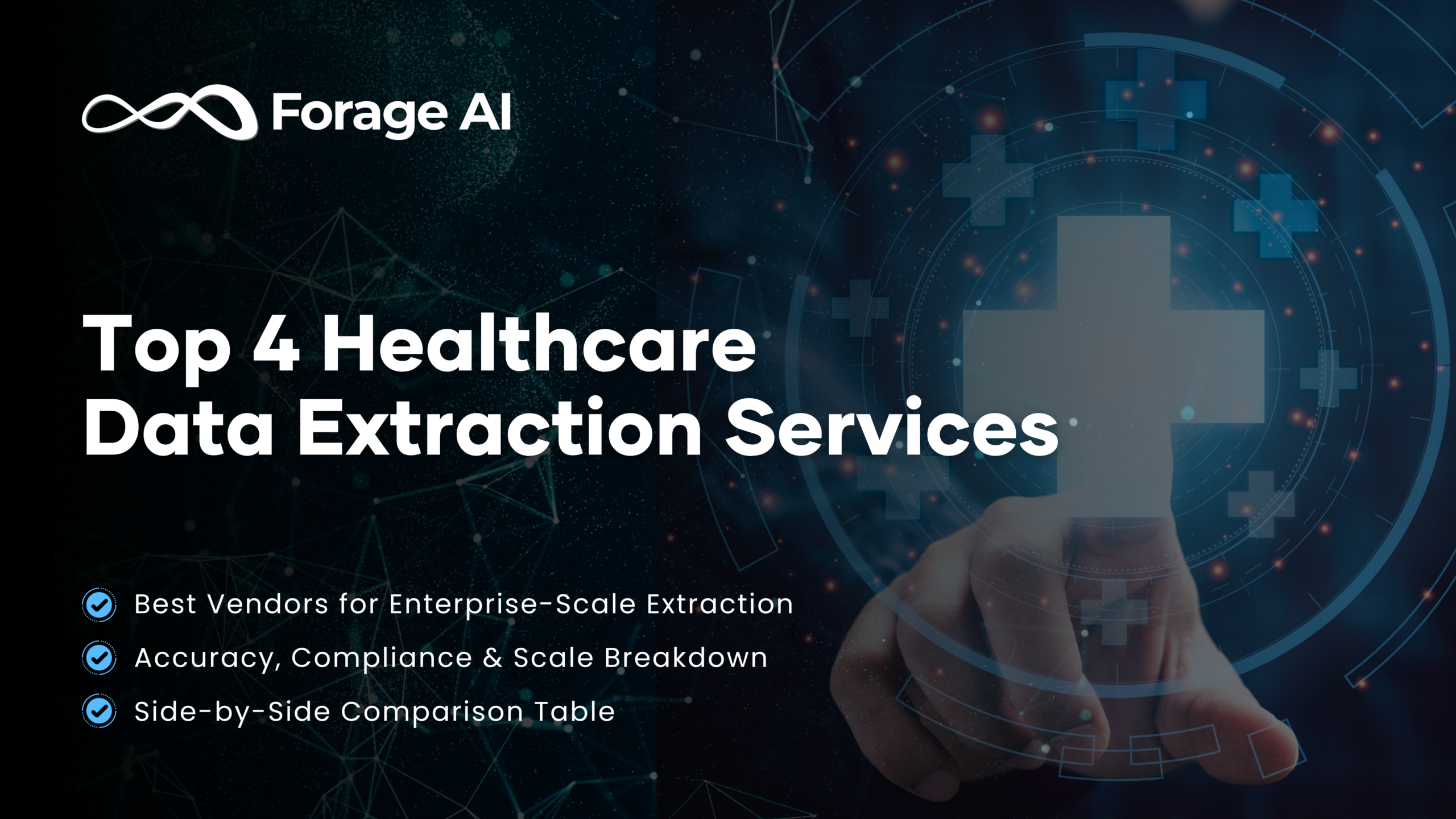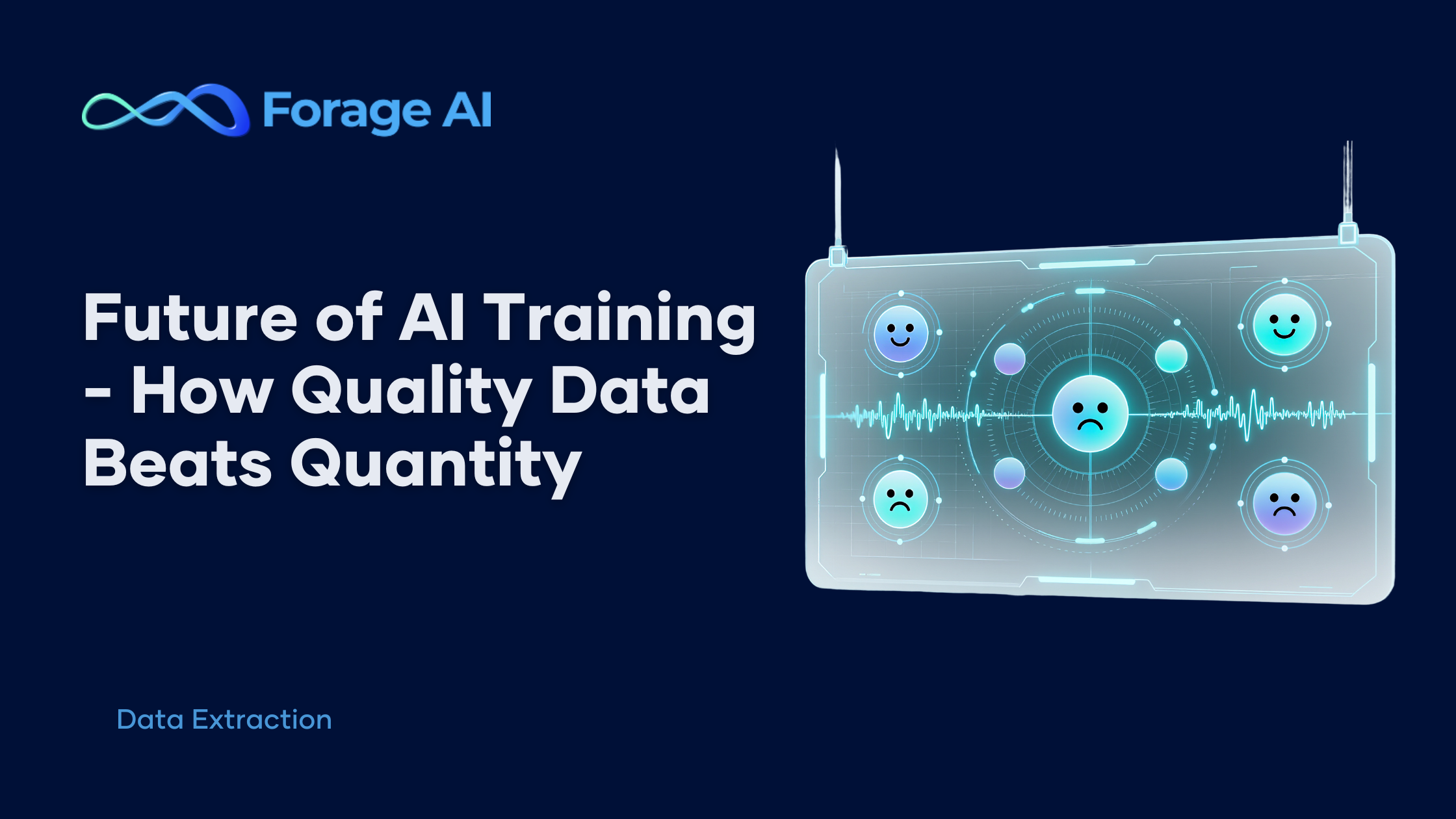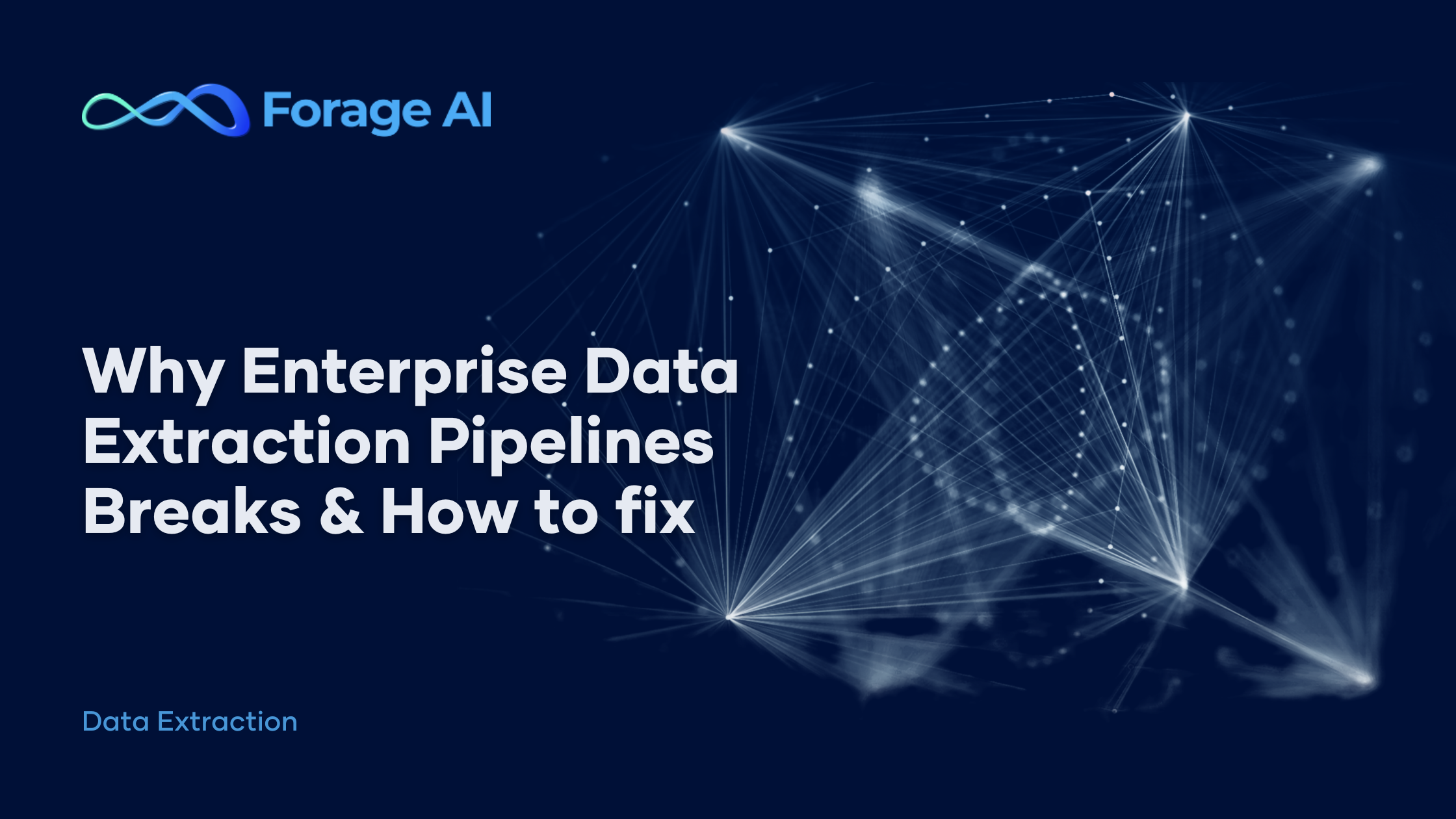The complexity of document management is growing as businesses increasingly rely on digital workflows. For organizations managing large volumes of data, the need to handle, extract, and analyze information in real time is evident. Intelligent Document Processing (IDP), powered by Generative AI, Large Language Models (LLMs), and Vision Language Models (VLMs), has emerged as the solution to these modern challenges. By automating document workflows, categorizing content, and ensuring compliance, IDP is transforming how companies approach document management.
In this blog, we dive into 10 powerful ways IDP is revolutionizing document management, highlighting the transformative capabilities that can directly benefit your organization. As we explore each method, we’ll also look at how Forage stands at the forefront, delivering tailored solutions for businesses seeking to streamline and optimize their document processes.
1. Automated Data Extraction with Unparalleled Accuracy and Context Understanding
The cornerstone of IDP’s revolutionary impact lies in its ability to extract data with a level of accuracy and contextual understanding that was previously unattainable. Traditional Optical Character Recognition (OCR) systems, while useful, often fall short when confronted with complex document structures or variations in format.
IDP elevates this process through:
- Advanced Vision Language Models (VLMs): These models don’t just recognize text; they understand it. By leveraging natural language processing (NLP), computer vision, and multimodal learning techniques, IDP solutions can interpret the semantic meaning of extracted data.
- Contextual Analysis: IDP systems analyze the relationships between different data points within a document. For instance, in a financial statement, the system doesn’t just extract numbers; it understands which numbers represent revenue, expenses, or profit margins based on their context.
- Handling of Unstructured Data: While structured forms are relatively straightforward, IDP truly shines when processing unstructured documents like contracts, emails, or reports. It can identify key clauses, extract relevant dates, and pinpoint critical information even when it’s not presented in a tabular format.
Forage AI’s proprietary models excel in this area, employing state-of-the-art Vision Language Models (VLMs) and Transformer-based architectures trained on vast datasets of diverse document types. This allows for:
- Parsing of complex table structures, including nested tables and those spanning multiple pages
- Accurate extraction from documents with varying layouts and formats
- Recognition and interpretation of handwritten text, even in cursive or non-standard scripts
The implications of this capability are profound. Organizations can now automate the extraction of critical data from a wide array of documents, from invoices and purchase orders to legal contracts and medical records. This not only dramatically reduces manual data entry but also minimizes human errors and accelerates processing times by orders of magnitude.
2. Multi-Format Document Support: Breaking Down Silos
In today’s digital ecosystem, information is stored and transmitted in a myriad of formats. IDP’s ability to handle this diversity is essential for dismantling information silos and establishing a unified data processing pipeline.
Modern IDP solutions support an extensive range of document formats:
- PDFs (both scanned and digital)
- Images (JPEG, PNG, TIFF, BMP)
- Microsoft Office files (Word, Excel, PowerPoint)
- Email attachments and body content
- HTML and XML files
- Specialized formats like CAD drawings or medical imaging files
Forage AI’s platform takes this versatility a step further by offering:
- Format-Agnostic Processing: The system leverages advanced machine learning and Vision Language Models (VLMs) to automatically detect and process the correct format without manual intervention, streamlining workflows.
- Preservation of Original Formatting: When extracting data, Forage AI utilizes multimodal AI to maintain the structural integrity of the original document, which is vital for ensuring compliance and supporting auditing requirements.
- Advanced Conversion Capabilities: The platform can convert between formats as needed using transformer-based models, ensuring that extracted data can be easily integrated into any existing system while preserving context and meaning.
This multi-format support is not just about convenience; it’s a critical factor in achieving true digital transformation. By eliminating format-based barriers, organizations can create cohesive information flows, dissolve departmental boundaries, and foster more effective collaboration and decision-making. To learn more about the different types of formats used in data extraction, check out our blog here: Decoding Data Types in Data Extraction: Text, Images, and Beyond.
3. Contextual Understanding: The Power of Intelligent Extraction
The leap from basic OCR to intelligent document processing is largely due to the incorporation of contextual understanding. This capability transforms IDP from a mere text recognition tool into a sophisticated system capable of interpreting and categorizing information based on its context within the document.
Key aspects of contextual understanding in IDP include:
- Semantic Analysis: IDP systems employ advanced NLP techniques, supported by Large Language Models (LLMs) and Retrieval-Augmented Generation (RAG), to grasp the meaning behind the words, not just their literal representation. This approach allows the system to fetch relevant context from a knowledge base, enhancing the interpretation of ambiguous terms or industry-specific jargon.
- Relationship Mapping: The technology utilizes Transformer-based models to identify relationships between different pieces of information within a document. For example, a legal contract can link clauses to their corresponding subsections or identify all parties mentioned and their roles.
- Intent Recognition: Advanced IDP solutions leverage Vision Language Models (VLMs) and reinforcement learning to infer the intent behind certain document elements. An email, for instance, can distinguish between a casual mention and a formal request or commitment.
Forage AI’s advanced NLP models excel at interpreting complex documents:
- Legal Document Analysis: The system can extract key clauses, identify potential risks, and summarize lengthy contracts.
- Financial Report Interpretation: It can pull out critical financial metrics, even when they’re embedded in narrative sections of annual reports.
- Medical Record Processing: The technology can interpret doctor’s notes, extract diagnoses, and link symptoms to potential conditions.
This level of contextual understanding enables organizations to not just digitize their documents, but to truly unlock the value hidden within them. It transforms raw text into actionable insights, enabling more informed decision-making and strategic planning.
4. Adaptive Learning: Continuous Improvement Through AI
One of the most transformative aspects of modern IDP systems is their ability to learn and improve over time. This adaptive learning capability ensures that the system becomes more efficient and accurate with each document processed.
Key features of adaptive learning in IDP include:
- Self-Improving Algorithms: The system leverages reinforcement learning and Transformer-based models to learn from each interaction, refining its understanding of document structures and content patterns.
- Feedback Loops: When errors are identified and corrected by human operators, the system incorporates this feedback through active learning techniques to prevent similar mistakes in the future.
- Anomaly Detection: Advanced IDP systems, utilizing Vision Language Models (VLMs), can identify unusual patterns or outliers, flagging them for human review and continuously improving their ability to handle edge cases.
Forage AI’s adaptive learning system is particularly sophisticated:
- It employs reinforcement learning techniques to optimize extraction strategies based on success rates.
- The system can generalize learnings from one document type to improve performance on similar but previously unseen formats.
- It features an active learning component that identifies areas of uncertainty and requests human input to improve its models strategically.
This continuous improvement cycle has far-reaching implications:
- Reduced Need for Manual Configuration: As the system learns, the need for manual rule-setting and template creation diminishes.
- Handling of Evolving Document Types: The adaptive nature allows the system to keep pace with changes in document formats and styles over time.
- Customization to Organizational Needs: The system becomes increasingly attuned to the specific document types and information needs of each organization.
By leveraging adaptive learning, IDP solutions ensure that document processing capabilities grow alongside an organization’s needs, providing a future-proof solution to information management challenges.
5. Seamless Integration: Enhancing Existing Workflows
The true power of IDP is realized when it’s seamlessly integrated into an organization’s existing workflows and systems. This integration transforms IDP from a standalone solution into a core component of the enterprise information architecture.
Key aspects of IDP integration include:
- API-First Design: Modern IDP platforms offer robust APIs that allow for easy integration with a wide range of enterprise systems.
- Pre-built Connectors: Many solutions come with out-of-the-box connectors for popular enterprise software, enabling quick deployment.
- Customizable Workflows: The ability to create custom processing pipelines that align with specific business processes.
- Forage AI’s integration capabilities stand out in several ways:
- Bi-Directional Data Flow: Not only can Forage AI push extracted data to other systems, but it can also pull contextual information to enhance its processing accuracy.
- Real-Time Processing: The platform supports real-time document processing, allowing for immediate data availability in connected systems.
- Flexible Deployment Options: Whether on-premises, cloud-based, or in a hybrid environment, Forage AI adapts to existing IT infrastructures.
Examples of Powerful Integrations:
| System Type | Integration Benefits |
|---|---|
ERP Systems | – Automated data entry into financial modules- Real-time update of inventory based on processed purchase orders- Streamlined vendor management through automated invoice processing |
| CRM Platforms | – Instant update of customer records with data from incoming correspondence- Automated processing of customer contracts and agreements- Enhanced customer service through quick access to relevant document data |
| Content Management Systems | – Automated document classification and indexing- Intelligent metadata tagging based on extracted content- Enhanced search capabilities across the document repository |
These integrations not only streamline operations but also create a more cohesive and responsive information ecosystem within the organization. For more insights on the challenges and solutions related to integrating IDP with existing enterprise systems, check out our blog here: Integrating IDP with Existing Enterprise Systems: Challenges and Solutions.
6. Enhanced Security and Compliance: Safeguarding Sensitive Information
In an era of increasing data regulation and cybersecurity threats, IDP plays a vital role in enhancing document security and ensuring compliance with various regulatory standards.
Key security and compliance features of advanced IDP systems include:
- Automated Data Redaction: Intelligent identification and redaction of sensitive information such as personal identifiers, financial data, or proprietary information.
- Audit Trails: Detailed logging of all document access and processing activities, important for compliance with regulations like GDPR or CCPA.
- Role-Based Access Control (RBAC): Granular control over who can access, view, or modify different types of documents and extracted data.
- Data Encryption: Both at rest and in transit, ensuring that sensitive information remains protected throughout the processing pipeline.
- Compliance Checks: Automated scanning of documents for compliance with industry-specific regulations or internal policies.
Forage AI’s platform is built with enterprise-grade security, offering:
- AI-Powered Anomaly Detection: The system can identify unusual patterns in document content or access that might indicate a security breach or compliance issue.
- Adaptive Redaction: The platform learns from user feedback to improve its ability to identify and redact sensitive information across various document types.
- Compliance Reporting: Automated generation of compliance reports, reducing the burden on legal and IT teams.
- Integration with Identity Management Systems: Seamless integration with enterprise identity and access management solutions for enhanced security.
The implications of these security and compliance features are significant:
- Risk Mitigation: By automating sensitive data handling, organizations can significantly reduce the risk of data breaches or compliance violations.
- Streamlined Audits: The detailed audit trails and compliance reporting capabilities simplify the auditing process, saving time and resources.
- Enhanced Trust: Robust security measures build trust with customers and partners, which is fundamental in industries dealing with sensitive information.
By incorporating these advanced security and compliance features, IDP solutions like Forage AI not only streamline document processing but also play a critical role in an organization’s overall risk management and compliance strategy.
7. Real-Time Analytics and Insights: Turning Documents into Business Intelligence
One of the most transformative aspects of modern IDP systems is their ability to generate real-time analytics and insights from processed documents. This capability turns document management from a passive, archival function into a dynamic source of business intelligence.
Key features of IDP analytics include:
- Processing Efficiency Dashboards: Real-time monitoring of document processing rates, accuracy levels, and bottlenecks.
- Content Analysis: Automated categorization and trend analysis of document contents, providing insights into customer sentiment, market trends, or internal process efficiency.
- Predictive Analytics: Using historical data to forecast future document volumes, processing requirements, or potential issues.
- Anomaly Detection: Identification of unusual patterns or outliers in document content or metadata, integral for detecting anomalies that could indicate fraud or quality control issues.
Forage AI’s analytics suite goes beyond basic reporting:
- Interactive Visualizations: Dynamic, customizable dashboards that allow users to explore data and uncover insights visually.
- Natural Language Querying: Users can ask questions about their document data in plain language and receive instant answers.
- Cross-Document Analysis: Using Retrieval-Augmented Generation (RAG), the system can pull in relevant information from other documents or databases during analysis, providing a richer, more contextually relevant view across multiple document types and sources.
- AI-Driven Recommendations: The system leverages RAG to retrieve pertinent information and can proactively suggest process improvements or highlight areas requiring attention based on analyzed data. These are generated using deep learning models, enhancing accuracy and relevance.
The impact of these analytics capabilities is far-reaching:
- Informed Decision Making: Leaders can make data-driven decisions based on comprehensive, up-to-date information extracted from across the organization’s document ecosystem.
- Process Optimization: By identifying bottlenecks and inefficiencies in document workflows, organizations can continuously improve their processes.
- Risk Management: Early detection of anomalies or trends can help organizations proactively address potential risks or compliance issues.
By transforming raw document data into actionable insights, IDP analytics empower organizations to manage their documents more effectively and derive strategic value from their information assets.
8. Handling of Complex, Multi-Page Documents: Conquering Information Complexity
One of the most significant challenges in document processing has been dealing with complex, multi-page documents that contain varied layouts, mixed content types, and intricate information structures. Modern IDP solutions excel in this area, offering sophisticated capabilities for parsing and extracting data from even the most complex document formats.
Key capabilities in handling complex documents include:
- Intelligent Layout Analysis: Advanced algorithms powered by Vision Language Models (VLMs) can understand and interpret various document layouts, including multi-column formats, sidebars, and floating elements.
- Cross-Page Context Understanding: The ability to maintain context across multiple pages is required for documents like lengthy contracts or technical manuals.
- Mixed Content-Type Processing: Seamless handling of documents that combine text, tables, images, and graphs.
- Logical Structure Recognition: Identification of document structure elements like chapters, sections, and subsections, even when not explicitly marked.
Forage AI’s advanced multi-modal AI systems and NLP algorithms offer exceptional performance in processing complex documents:
- Adaptive Table Extraction: The system can accurately extract data from complex tables, including those with merged cells, nested structures, or tables that span multiple pages.
- Intelligent Form Processing: Ability to handle variations in form layouts, including the understanding of form logic and relationships between fields.
- Technical Document Analysis: Specialized capabilities for processing complex technical documents like engineering specifications or scientific papers, including the ability to interpret diagrams and technical notation.
- Financial Statement Processing: Advanced capabilities in extracting and interpreting data from complex financial documents, including the ability to reconcile information across different sections of a report.
The implications of these capabilities are significant:
- Increased Automation: Even the most complex documents can now be processed with minimal human intervention, dramatically reducing manual processing time.
- Enhanced Data Accuracy: By understanding the full context and structure of complex documents, these systems can extract data with higher accuracy and reliability.
- Unlocking of Unstructured Data: Organizations can now easily access and analyze information that was previously locked in complex, unstructured documents.
- Improved Compliance: Better handling of complex documents ensures that critical information is not missed during regulatory compliance checks.
By conquering the challenges posed by complex, multi-page documents, IDP solutions like Forage AI are enabling organizations to fully digitize and leverage all their document-based information, regardless of complexity.
9. Multilingual Support: Breaking Down Language Barriers
In our increasingly globalized business environment, the ability to process documents in multiple languages is not just a convenience—it’s a necessity. Modern IDP solutions are breaking down language barriers, offering robust multilingual support that enables global document processing.
Key features of multilingual IDP include:
- Support for 100+ Languages: Advanced systems can recognize and process text in many languages, including those with non-Latin scripts.
- Language Detection: Automatic identification of the document language, allowing for appropriate processing without manual intervention.
- Cross-Language Information Extraction: The ability to extract and correlate information from documents in different languages.
- Handling of Mixed-Language Documents: Processing documents that contain multiple languages within the exact text.
Forage AI’s multilingual capabilities stand out in several ways:
- Context-Aware Translation: Not just literal translation, our systems use Large Language Models (LLMs) for nuanced understanding, going beyond literal translations to capture context and idiomatic language.
- Script and Font Versatility: Ability to accurately process various scripts and fonts, including handwritten text in different languages.
- Semantic Analysis Across Languages: Maintaining the ability to perform deep semantic analysis even when working with translated content.
- Customizable Language Models: The platform allows for the fine-tuning of language models to specific industries or organizational terminologies.
The impact of these multilingual capabilities is profound:
- Global Operations Support: Organizations can centralize their document processing, handling documents from various global offices in a single system.
- Enhanced Customer Service: Ability to quickly process and respond to customer communications in their preferred language.
- Expanded Market Reach: Easier processing of documents in different languages can facilitate expansion into new markets.
- Improved Compliance: Better handling of multilingual documents ensures compliance with local regulations in different countries.
By breaking down language barriers, IDP solutions like Forage AI are enabling organizations to operate more effectively on a global scale, fostering better communication and more efficient information flows across linguistic boundaries.
10. Scalability for Enterprise-Level Processing: Meeting the Demands of Big Data
As organizations deal with ever-increasing volumes of documents, the scalability of IDP solutions becomes essential. Modern IDP platforms are designed to handle massive document volumes, providing the processing power and flexibility needed for enterprise-level operations.
Key aspects of scalable IDP solutions include:
- Cloud-Based Processing: Forage AI leverages serverless architectures within cloud environments, ensuring seamless scaling with minimal configuration. This allows organizations to automatically adjust resources without manual intervention, optimizing cost and efficiency.
- Distributed Processing Architecture: Distributed processing is optimized through microservices, allowing Forage AI components to be scaled independently based on workload. This modular design provides the flexibility to handle varying demands across different document types and processing tasks, ensuring high availability and reliability.
- Load Balancing: Intelligent distribution of processing tasks ensures consistent performance even during peak loads. Forage AI maintains high throughput and efficiency by balancing workloads across multiple servers.
- Batch Processing Capabilities: Efficient handling of large batches of documents is crucial for the periodic processing of high volumes, allowing organizations to manage their workflows seamlessly.
- Elastic Scaling: Elastic scaling is achieved through dynamic resource orchestration, leveraging Kubernetes or similar orchestration tools for efficient scaling. This ensures that resources are scaled up or down automatically based on processing demands, providing consistent performance while optimizing resource utilization.
Forage AI’s cloud-native architecture offers exceptional scalability:
- Microservices Architecture: A modular design that allows for independent scaling of different processing components.
- Multi-Tenant Capabilities: Secure processing of documents from multiple departments or organizations within the same infrastructure.
- Global Data Centers: Using geographically distributed data centers to ensure low-latency processing regardless of document origin.
- Hybrid Cloud Support: Flexibility to combine on-premises and cloud-based processing to meet specific security or compliance requirements.
The implications of this scalability are significant:
- Consistent Performance: Organizations can maintain rapid processing times as document volumes grow.
- Cost Efficiency: Cloud-based scaling allows for more efficient resource utilization, with costs aligning closely with actual usage.
- Business Continuity: Enhanced resilience and disaster recovery capabilities ensure uninterrupted document processing.
- Future-Proofing: The ability to quickly scale up processing capacity allows organizations to expand their digital transformation initiatives confidently.
By providing enterprise-level scalability, IDP solutions like Forage AI ensure that organizations can handle their current document processing needs while being prepared for future growth and evolving business requirements.
Conclusion: Embracing the IDP Revolution
Intelligent Document Processing (IDP) is not just an incremental improvement in document management—it’s a transformative shift in how organizations derive value from their information. By leveraging cutting-edge technologies like AI, machine learning, natural language processing, and Retrieval-Augmented Generation (RAG), Forage AI empowers organizations to:
- Extract data with unmatched accuracy and contextual understanding.
- Break down information silos, processing diverse document formats seamlessly.
- Turn raw text into actionable insights through advanced contextual interpretation.
- Continuously learn and adapt, ensuring long-term efficiency.
- Integrate effortlessly with existing systems, enhancing workflow efficiency.
- Strengthen security and compliance, safeguarding sensitive information.
- Generate real-time analytics, turning documents into strategic assets.
- Handle complex, multi-page documents with ease.
- Break down language barriers for truly global operations.
- Scale efficiently to meet enterprise-level demands.
The impact of these capabilities goes beyond efficiency. IDP enables organizations to reallocate resources to high-value tasks, make informed decisions, enhance customer experiences, reduce compliance risks, and unlock the hidden value in unstructured data.
As digital transformation accelerates, adopting IDP is not optional—it’s essential for staying competitive in a data-driven world. Forage AI is at the forefront of this revolution, combining cutting-edge technology with deep domain expertise to help organizations unlock the full potential of their information assets.
Are you ready to harness the power of your document data and transform your workflows? Contact Forage AI for a personalized demo and discover how intelligent document processing can be tailored to meet your unique business needs. Take the first step towards revolutionizing your approach to information management today.
